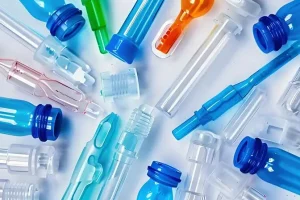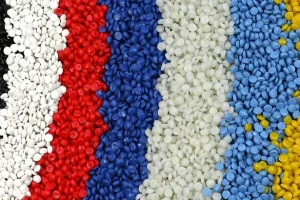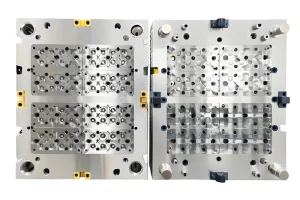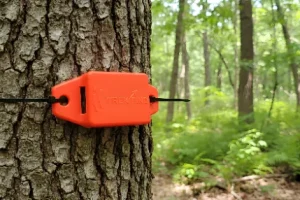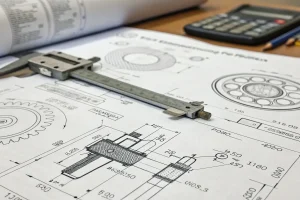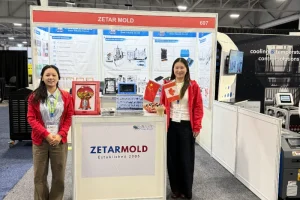Injection molding is a super popular way to make a ton of plastic parts in a hurry. It’s fast and efficient. But one of the most important things you need to get right is picking the right plastic. In this post, we’ll look at the most common plastics used in injection molding and talk about what they’re good for.
PS (Polystyrene)
1. Performance
PS is a shapeless polymer with good flowability and low water absorption (less than 0.2%). It is a see-through plastic that is easy to mold. Its products have a light transmittance of 88-92%, strong coloring ability, and high hardness. However, PS products are brittle, prone to internal stress cracking, have poor heat resistance (60-80°C), are non-toxic, and have a specific gravity of around 1.04 g/cm³ (a little heavier than water).
2. Application
Stuff like containers, lids, bottles, medical supplies you throw away, toys, cups, knives, tape spools, windshields, and lots of foam products like egg cartons. Meat and poultry trays, bottle labels, and foam cushioning materials, product packaging, household items (utensils, trays, etc.), electrical (transparent containers, light diffusers, insulating films, etc.).

HIPS (High Impact Polystyrene)
1. Performance
HIPS is a modified material of PS, containing 5-15% rubber components in its molecules, which increases its toughness by about four times compared to PS. It has greatly improved impact strength (high impact polystyrene) and comes in various grades such as flame retardant, stress cracking resistant, high gloss, extremely high impact strength, glass fiber reinforced, and low residual volatile content.
2. Application
Mostly used in packaging and disposable products, appliances, toys, entertainment products, and the construction industry. Flame retardant grades (UL V-0 and UL 5-V) and high impact polystyrene are widely used in TV cases, commercial machinery, and electrical products.

SAN (Styrene-Acrylonitrile Copolymer)
1. Performance
Chemical and Physical Properties: SAN is a hard, clear material that resists cracking under stress. It is more transparent, has a higher softening temperature, and is more impact resistant than PS. The styrene makes SAN hard, clear, and easy to process; the acrylonitrile gives SAN chemical and thermal stability. SAN has good load-bearing capacity, chemical resistance, heat resistance, and dimensional stability.
2. Application
Electrical (sockets, housings, etc.), daily commodities (kitchen utensils, refrigerator devices, TV bases, tape boxes, etc.), automotive industry (headlight housings, reflectors, dashboards, etc.), household items (tableware, food knives, etc.), cosmetic packaging, safety glass, water filter housings, and faucet handles. Medical products (syringes, blood suction tubes, dialyzers, and reactors). Packaging materials (cosmetic boxes, lipstick tubes, mascara cap bottles, caps, spray bottles, and nozzles), special products (disposable lighter shells, brush substrates and bristles, fishing tackle, dentures, toothbrush handles, pen shafts, musical instrument mouthpieces, and directional monofilaments), etc.

ABS (Acrylonitrile Butadiene Styrene)
1. Performance
ABS is made from three chemicals: acrylonitrile, butadiene, and styrene. ABS is a light yellow opaque resin, non-toxic, odorless, with low water absorption, and has excellent comprehensive physical and mechanical properties, such as excellent electrical properties, wear resistance, dimensional stability, chemical resistance, and surface gloss. However, it has poor weather resistance, heat resistance, and is flammable.
2. Application
Car (dashboard, glove box doors, wheel covers, mirror housings, etc.), fridges, high-strength tools (hair dryers, mixers, food processors, lawnmowers, etc.), phone cases, typewriter keyboards, recreational vehicles like golf carts and jet snow plows, etc.

BS (Butadiene-Styrene Copolymer)
1. Performance
BS is a copolymer of butadiene and styrene. It has toughness, elasticity, low hardness (soft), and good transparency. The density of BS resin is about 1.01 g/cm³ (similar to water). It is easy to color, has good fluidity, and is easy to mold.
2. BS Process Characteristics
The processing temperature of BS is generally suitable between 190-225°C, and the mold temperature is preferably between 30-50°C. The material should be dried before processing. Due to its good fluidity, injection pressure and injection speed can be lower.
3. Application
It is used in injection molding, blow molding, extrusion, and other processing methods. It is widely used in the manufacture of transparent products that are not easy to break, such as cups, lids, bottles, hinged boxes, hangers, packaging for food and medical use, etc.

PMMA (Polymethyl Methacrylate)
1. Performance
PMMA is an amorphous polymer, commonly known as acrylic glass. It has excellent transparency, good heat resistance (softening temperature of 98°C), good impact resistance, medium mechanical strength, low surface hardness, and is prone to scratching, but it has excellent optical properties and resistance to climate change.
2. Application
Car parts (turn signals, dashboards, etc.), medical stuff (blood storage containers, etc.), industrial stuff (DVDs, light diffusers), everyday stuff (cups, pens, etc.).

PE (Polyethylene)
1. Performance
PE is the most produced plastic in the world. It is soft, non-toxic, cheap, easy to process, has good chemical resistance, is corrosion resistant, and is hard to print on.
2. Application
PE applications include films, molding, pipes, wires and cables, refrigerator containers, storage containers, household kitchenware, sealing caps, and so on.

PP (Polypropylene)
1. Performance
PP is a crystalline polymer. Among commonly used plastics, PP is the lightest, with a density of only 0.91 g/cm³ (less than water). PP has the best heat resistance among general-purpose plastics, with a heat deformation temperature of 80-100°C, and can be boiled in boiling water. PP has good stress crack resistance, high flexural fatigue life, commonly known as “hundred fold gum”.
2. Application
Cars (mostly with metal additives: mudguards, ventilation pipes, fans, etc.), instruments (dishwasher door liners, dryer vents, washing machine frames and covers, refrigerator door liners, etc.), everyday stuff (lawn and garden equipment like lawnmowers and sprinklers), etc. Injection-molded PP is the second biggest market for homopolymers, including containers, seals, car stuff, household stuff, toys, and lots of other stuff people use.

PA (Nylon)
1. Performance
PA is a crystalline plastic (nylon is a tough, angular, semi-transparent or milky white crystalline resin). As an engineering plastic, the molecular weight of nylon is generally 15,000-30,000, with many varieties used in injection molding. Its main advantages are high mechanical strength, good toughness, fatigue resistance, smooth surface, high softening point, heat resistance, low friction coefficient, wear resistance, self-lubrication, shock absorption, and sound absorption, oil resistance, weak acid resistance, alkali resistance, and general solvent resistance, good electrical insulation, self-extinguishing, non-toxic, odorless, good weather resistance. The disadvantage is its high water absorption, poor dyeing, which affects dimensional stability and electrical properties.
2. PA Process Characteristics
PA is hygroscopic and must be thoroughly dried before processing, with a moisture content of less than 0.3%. PA has a much lower viscosity than other thermoplastics, and its melting temperature range is narrow (only about 5°C). PA has poor thermal stability and is prone to degradation when melted.
3. Application
Water meters and other commercial equipment, cable sheaths, mechanical cams, sliding mechanisms, bearings, automotive industry, instrument housings, and other products that need to be strong and tough.

POM (Polyoxymethylene)
1. Performance
POM is a crystalline plastic, known for its excellent stiffness, commonly known as “steel.” POM is tough and elastic, with excellent creep resistance, dimensional stability, and impact resistance even at low temperatures. It has excellent fatigue resistance, creep resistance, wear resistance, heat resistance, etc.
2. Application
POM has low friction and good dimensional stability, making it particularly suitable for making gears and bearings. Due to its high temperature resistance, it is also used in pipe fittings (pipe valves, pump housings), lawn equipment, etc.

PC (Polycarbonate)
1. Performance
PC is a kind of engineering plastic. It is amorphous, odorless, non-toxic, highly transparent, colorless or slightly yellow, and has excellent physical and mechanical properties. It has outstanding impact resistance, high tensile strength, bending strength, and compressive strength. It has good toughness, heat resistance, weather resistance, easy coloring, and low water absorption. The heat distortion temperature of PC is 135-143°C. It has low creep, dimensional stability, good heat resistance, low-temperature resistance, stable mechanical properties, dimensional stability, electrical properties, and flame retardancy over a wide temperature range (-60-120°C). PC can be injection molded, extruded, compression molded, blow molded, printed, bonded, coated, and machined. The most important processing method is injection molding.
2. Application
PC has three major application areas: glass assembly, automotive industry, electronics, electrical industry, followed by industrial machinery parts, CDs, civilian clothing, office equipment such as computers, medical and health care, films, leisure and protective equipment, etc.

EVA (Ethylene Vinyl Acetate)
1. Performance
EVA is a kind of plastic that doesn’t have a shape, it’s not poisonous, and it’s lighter than water. The things made from it don’t look shiny, but they can stretch, they’re light, they’re not very strong, they’re easy to make, and they’re easy to work with. It shrinks a lot (2%) and you can put color in it.
2. Application
EVA materials can be used to make household appliances like refrigerator pipes, gas pipes, construction boards, containers, and daily necessities. It can also be used for packaging films, gaskets, medical equipment, hot melt adhesives, cable insulation layers, etc.

PVC (Polyvinyl Chloride)
1. Performance
PVC is a plastic that doesn’t like heat and can break down if you don’t melt it right. It’s hard to burn (good fire resistance), thick, doesn’t flow well, strong, can handle the weather, and doesn’t change shape much. PVC usually has stabilizers, slippery stuff, helpers, colors, things to make it stronger, and other things added to it.
2. Application
Water supply pipes, household pipes, house wall panels, commercial machine casings, electronic product packaging, medical devices, food packaging, and so on.

PPO (Polyphenylene Oxide)
1. Performance
PPO (NORLY) is a kind of engineering plastic with excellent comprehensive performance. It has higher hardness than PA, POM, and PC, high mechanical strength, good rigidity, good heat resistance (heat deformation temperature of 126°C), high dimensional stability (shrinkage rate of 0.6%), and low water absorption (less than 0.1%). The disadvantage is its instability to ultraviolet light, high price, and low usage. PPO is non-toxic, transparent, and has a relatively small relative density, with excellent mechanical strength, stress relaxation resistance, creep resistance, heat resistance, water resistance, and water vapor resistance.
2. Application
PPO can be processed by injection molding, extrusion, blow molding, compression molding, foaming, electroplating, vacuum coating, printing, and other methods, due to its high melt viscosity and processing temperature.
Mainly used in electronics, automotive, household appliances, office equipment, and industrial machinery.

PBT (Polybutylene Terephthalate)
1. Performance
PBT is one of the toughest engineering thermoplastics. It is a semi-crystalline material with excellent chemical stability, mechanical strength, electrical insulation properties, and thermal stability. These materials have good stability under a wide range of environmental conditions.
2. Application
Stuff like food processor blades, vacuum cleaner parts, electric fans, hair dryer shells, coffee maker parts, and all that. Also, things like switches, motor housings, fuse boxes, computer keys, and all that electrical stuff. And car stuff too, like grilles, body parts, hubcaps, door and window parts, and all that.

How to Choose Injection Molding Materials?
1. Understand Your Product Requirements
Make sure you know exactly what you want your product to do. Think about things like how strong it needs to be, how bendy it needs to be, what chemicals it needs to be able to handle, how hot it needs to be able to get, and how pretty it needs to be.
2. Evaluate Mechanical Performance
Different applications require materials with specific mechanical properties. Determine the desired levels of strength, flexibility, and impact resistance for your product. For example, automotive parts may require high strength and impact resistance, while consumer goods may prioritize flexibility and durability.

3. Assess Thermal Performance
Think about the temperature range your product will work in. Pick materials with the right heat resistance and melting points to make sure they stay stable when you mold and use them. If you’re using your product in high temperatures, you might need materials that stay stable in heat, like polycarbonate or polyphenylene sulfide (PPS) engineering plastics.
4. Consider Chemical Resistance
If your product is going to be exposed to chemicals or environmental factors, you’ll want to choose materials that are resistant to corrosion and degradation. For example, if you’re making products for the automotive, medical, or chemical industries, you might need materials that are really good at resisting chemicals, like polypropylene (PP) or polyethylene terephthalate (PET).

5. Evaluate Cost and Availability
Think about how much the stuff you need costs and if you can get it. You want to make sure you’re getting the most bang for your buck, but you also want to make sure the stuff you’re getting is going to work. Also, make sure you can get the stuff you need when you need it so you don’t have to stop making stuff.
6. Assess Desired Aesthetics
Think about how your product will look and feel. Some materials come in different colors and finishes, which gives you more options for how your product will look. If you want your product to be see-through, you can use materials like polycarbonate (PC) or acrylic (PMMA). You can also add things to your material to make it a certain color or do something special.

7. Research Common Materials
Get to know the properties and characteristics of commonly used injection molding materials like polyethylene (PE), polypropylene (PP), acrylonitrile butadiene styrene (ABS), etc. Each material has its own pros and cons, so pick the one that best suits your product needs.
8. Consult Material Suppliers and Experts
Ask your material suppliers, injection molding experts, or engineers with experience in your industry. They can give you good advice and tell you what materials are available and what processes are available. They can tell you what you can do and what you can’t do.

9. Prototyping and Testing
Before you finalize your material selection, make sure you prototype and test the crap out of it. This will help you catch any issues early on and make the necessary adjustments.
10. Consider Environmental and Regulatory Factors
Consider the environment and the law when you pick materials. Use stuff that can be recycled, broken down by nature, or that follows the rules and standards to keep the environment safe and stay out of trouble.

Conclusion
Picking the right plastic is super important for injection molding success. You can choose the best material for your specific application by thinking about things like how strong it is, how it handles heat, how it handles chemicals, how much it costs, how it looks, and how easy it is to get. Knowing what different plastics are like and what they’re good for is key to making good parts fast and cheap.


